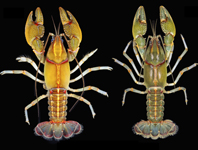Abstract
The majority of tyrannosauroid phylogenies published in the last 10 years have recovered a clade of basal tyrannosauroids that include Stokesosaurus clevelandi Madsen, 1974, Eotyrannus lengi Hutt et al., 2001 and Juratyrant langhami (Benson, 2008), which is positioned between Dilong Xu et al., 2004 and more derived tyrannosauroids such as Xiongguanlong Li et al., 2010 (e.g., Brusatte et al., 2010, 2011; Brusatte and Benson, 2013; Lü et al., 2014; Brusatte and Carr, 2016; Yun, 2016; Carr et al., 2017; Delcourt and Grillo, 2018; Nesbitt et al., 2019; Zanno et al., 2019; Wu et al., 2020). Carr et al. (2017) first called this clade as “Stokesosauridae”, but did not define or diagnose this clade; but later the name was adopted and used as valid by Wu et al. (2020).
References
Benson, R.B.J. (2008) New information on Stokesosaurus, a tyrannosauroid (Dinosauria: Theropoda) from North America and the United Kingdom. Journal of Vertebrate Paleontology, 28, 732–750.
https://doi.org/10.1671/0272-4634(2008)28[732:NIOSAT]2.0.CO;2
Brusatte, S.L., Norell, M.A., Carr, T.D., Erickson, G.M., Hutchinson, J.R., Balanoff, A.M., Bever, G.S., Choiniere, J.N., Makovicky, P.J. & Xu, X. (2010) Tyrannosaur paleobiology: new research on ancient exemplar organisms. Science, 329, 1481–1485.
https://doi.org/10.1126/science.1193304
Brusatte, S.L., Benson, R.B.J. & Norell, M.A. (2011) The anatomy of Dryptosaurus aquilunguis (Dinosauria: Theropoda) and a review of its tyrannosauroid affinities. American Museum Novitates, 3717, 1–53.
https://doi.org/10.1206/3717.2
Brusatte, S.L. & Benson, R.B.J. (2013) The systematics of Late Jurassic tyrannosauroids (Dinosauria: Theropoda) from Europe and North America. Acta Palaeontologica Polonica, 58, 47–54.
https://doi.org/10.4202/app.2011.0141
Brusatte, S.L. & Carr, T.D. (2016) The phylogeny and evolutionary history of tyrannosauroid dinosaurs. Scientific Reports, 6, 20252.
https://doi.org/10.1038/srep20252
Carpenter, K., Miles, C. & Cloward, K. (2005) New small theropod from the Upper Jurassic Morrison Formation of Wyoming. In: Carpenter, K. (Ed.), 2005. The Carnivorous Dinosaurs. Indiana University Press, Bloomington, pp. 23–48.
Carr, T.D., Varricchio, D.J., Sedlmayr, J.C., Roberts, E.M. & Moore, J.R. (2017) A new tyrannosaur with evidence for anagenesis and crocodile-like facial sensory system. Scientific Reports, 7, 44942.
https://doi.org/10.1038/srep44942
Dalman, S.G., Jasinski, S.E. & Lucas, S.G. (2017) First occurrence of a tyrannosauroid dinosaur from the lower Campanian Merchantville Formation of Delaware, USA. Memoir of the Fukui Prefectural Dinosaur Museum, 16, 29–38.
Delcourt, R. & Grillo, O.N. (2018) Tyrannosauroids from the Southern Hemisphere: Implications for biogeography, evolution, and taxonomy. Palaeogeography, Palaeoclimatology, Palaeoecology, 511, 379–387.
https://doi.org/10.1016/j.palaeo.2018.09.003
Hutt, S., Naish, D., Martill, D.M., Barker, M.J. & Newbery, P. (2001) A preliminary account of a new tyrannosauroid theropod from the Wessex Formation (Cretaceous) of southern England. Cretaceous Research, 22, 227–242.
https://doi.org/10.1006/cres.2001.0252
ICZN (1999) International Code of Zoological Nomenclature. 4th Edition. International Trust for Zoological Nomenclature, c/o The Natural History Museum, London, 126 pp.
Li, D., Norell, M.A., Gao, K.Q., Smith, N.D. & Makovicky, P.J. (2010) A longirostrine tyrannosauroid from the Early Cretaceous of China. Proceedings of the Royal Society B: Biological Sciences, 277, 183–190.
https://doi.org/10.1098/rspb.2009.0249
Lü, J., Yi, L., Brusatte, S.L., Yang, L., Li, H. & Chen, L. (2014) A new clade of Asian Late Cretaceous long-snouted tyrannosaurids. Nature Communications, 5, 3788.
https://doi.org/10.1038/ncomms4788
Madsen, J.H. (1974) A new theropod dinosaur from the Upper Jurassic of Utah. Journal of Paleontology, 48, 27–31.
Nesbitt, S.J., Denton Jr, R.K., Loewen, M.A., Brusatte, S.L., Smith, N.D., Turner, A.H., Kirkland, J.I., McDonald, A.T. & Wolfe, D.G. (2019) A mid-Cretaceous tyrannosauroid and the origin of North American end-Cretaceous dinosaur assemblages. Nature Ecology & Evolution, 3, 892–899.
https://doi.org/10.1038/s41559-019-0888-0
Osborn, H.F. (1905) Tyrannosaurus and other Cretaceous carnivorous dinosaurs. Bulletin of the American Museum of Natural History, 21, 259–265.
Rauhut, O.W.M. (2003) A tyrannosauroid dinosaur from the Upper Jurassic of Portugal. Palaeontology, 46, 903–910.
https://doi.org/10.1111/1475-4983.00325
Woodward, A.S. (1910) On a skull of Megalosaurus from the Great Oolite of Minchinhampton (Gloucestershire). Quarterly Journal of the Geological Society of London, 66, 111–115.
https://doi.org/10.1144/GSL.JGS.1910.066.01-04.07
Wu, X.-C., Shi, J.-R., Dong, L.-Y., Carr, T.D., Yi, J. & Xu, S.-C. (2020) A new tyrannosauroid from the Upper Cretaceous of Shanxi, China. Cretaceous Research, 108, 104357.
https://doi.org/10.1016/j.cretres.2019.104357
Xu, X., Norell, M.A., Kuang, X., Wang, X., Zhao, Q. & Jia, C. (2004) Basal tyrannosauroids from China and evidence for protofeathers in tyrannosauroids. Nature, 431, 680–684.
https://doi.org/10.1038/nature02855
Yun, C.-G. (2016) A review of the basal tyrannosauroids (Saurischia: Theropoda) of the Jurassic Period. Volumina Jurassica, 14, 159–164.
https://doi.org/10.5604/01.3001.0009.4021
Zanno, J., Lindsay, E., Tucker, R.T., Canoville, A., Avrahami, H.M., Gates, T.A. & Makovicky, P.J. (2019) Diminutive fleet-footed tyrannosauroid narrows the 70- million-year gap in the North American fossil record. Communications Biology, 2, 64.

